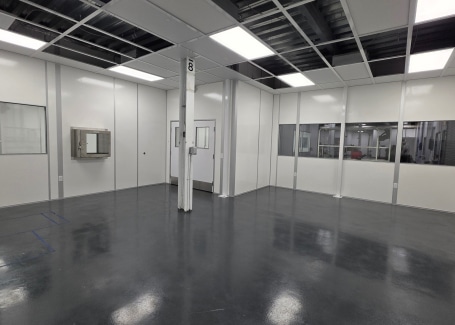Laminar airflow is an important element in many highly-controlled cleanrooms, including operating rooms, semiconductor fabrication plants, biotech labs, and more. But what exactly is it? And how does it contribute to cleanliness in cleanrooms? In the simplest terms possible, this article covers the basics of laminar airflow, its differences from other airflow types, its applications in cleanrooms, its benefits, and more.
What is Laminar Airflow?
Laminar airflow is a type of air movement that is consistent in velocity and direction. It moves in parallel layers, called “laminae,” which do not cross over each other.
In a cleanroom context, laminar air systems move air uniformly through high-efficiency particulate air (HEPA) filters, which keep the air clean. These systems aid cleanrooms in both removing and preventing airborne particles from critical spaces, and are typically used in ISO 5 cleanrooms and above.
Many cleanrooms also use laminar flow cabinets to ensure a sterile work area for sensitive tasks and product protection.
What is the Difference Between Laminar Airflow and Unidirectional Airflow?
While laminar airflow and unidirectional airflow are often used interchangeably, especially within a cleanroom context, there are a few subtle differences between them.
Both refer to air moving in a consistent, single direction. However, the term “laminar airflow” refers to the parallel nature of the air movement, the laminae.
To illustrate, imagine you are in a cleanroom which uses laminar airflow.
Within it, there are fan filter units in the ceiling that blow air towards grilles in the floor. The air is being pushed from the ceiling to the floor, vertically.
You have on a special pair of glasses, which allows you to see the smoky movement of the air in bright green.
The airflow appears much like multiple lanes of traffic on a highway, with each car (airflow) moving at the same speed, without switching lanes. The lanes do not cross over each other.
If we consider unidirectional airflow, on the other hand, it focuses only on the directionality of the air, especially in that it moves from one side to another (horizontally or vertically) without turbulence.
The key difference here is that with unidirectional airflow, you may have situations where the air “changes lanes,” so to speak, but still flows in one direction. In other words, unidirectional airflow is not as strict and is more inclusive than laminar airflow. The difference is minor, but important.

Applications of Laminar Airflow in Cleanrooms
Because of its effectiveness in removing particles from the air, laminar airflow is often used in a wide variety of applications, almost too many to name. Here are a few big industries that use laminar airflow:
Pharmaceutical Industry
In drug manufacturing, laminar airflow is often necessary to make medications and vaccines, especially in stages such as aseptic filling. These systems prevent contamination of both viable and non-viable particles that could affect the safety of products.
Semiconductor Industry
The semiconductor industry also relies on it to produce microchips and other electronic parts. One tiny particle can cause defects in these, so these airflow systems are the backbone of the overall manufacturing process.
Biotechnology/Research
Similarly, biotechnology and research labs use it to protect the accuracy of experiments. A constant and clean flow of air helps researchers obtain reliable results.
Medical Environments
In many medical environments, but especially in operating rooms, these airflow systems prevent particles from reaching patients. Surgery can be dangerous, as people are especially liable to infections right after it, and hospitals can be full of dangerous contaminants.
Benefits of Laminar Airflow in Cleanrooms
Though we’ve discussed some of the benefits of laminar airflow above, here are a few of the main ones that it provides in cleanrooms:
- Improved Cleanliness: With a constant flow of clean air, laminar systems remove particles from work environments effectively.
- Compliance with Regulatory Standards: Many industries must meet strict regulations, such as ISO and GMP, and laminar airflow systems aid them in reaching the right classifications.
- Precision in Manufacturing and Research: Given that a very small number of particles can affect sensitive products and research processes, this type of airflow is necessary in precision work.
The Bottom Line
As parts become smaller an more intricate, laminar airflow will play an increasingly important role in many industries that require a high degree of precision and cleanliness. By understanding it, its applications, and benefits, organizations can better design and manage cleanrooms.






